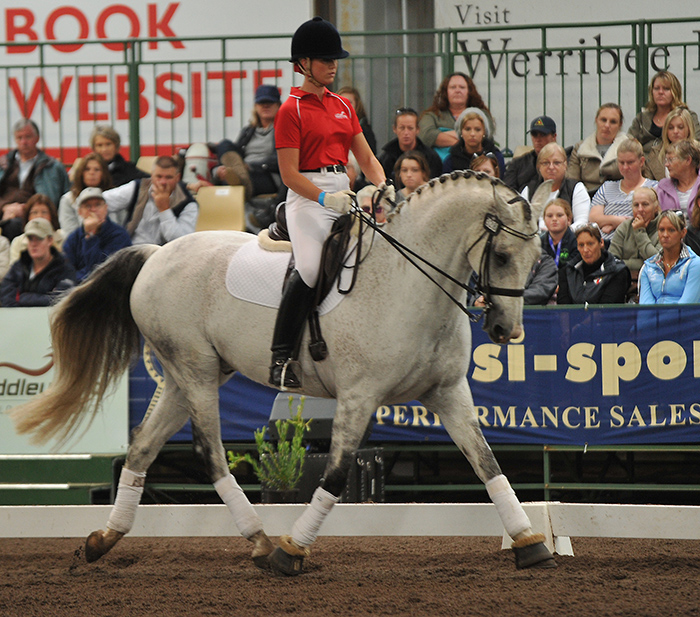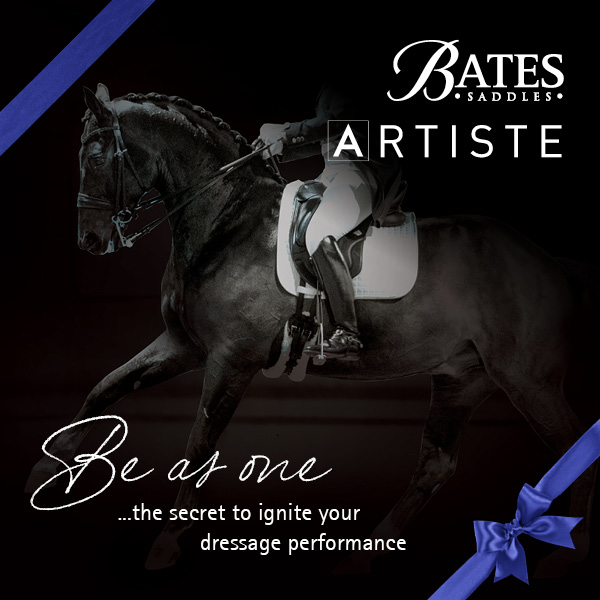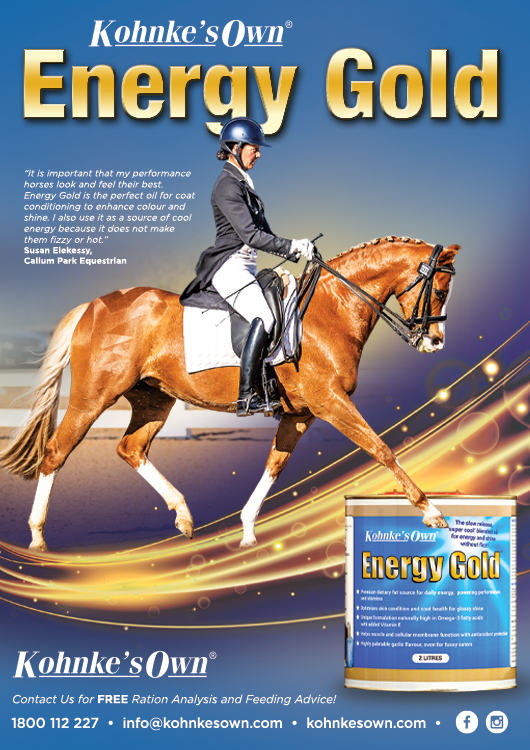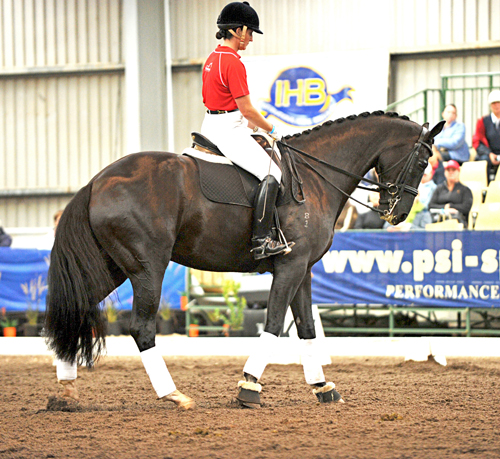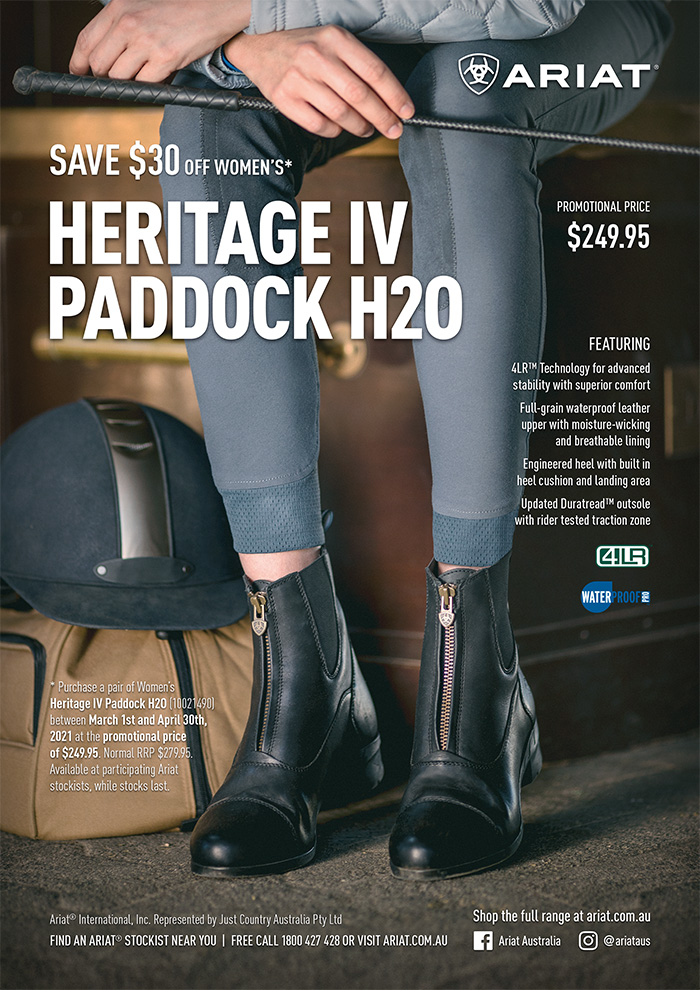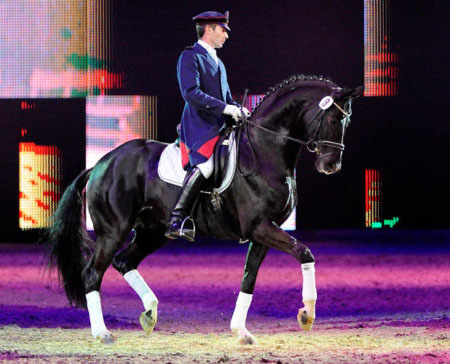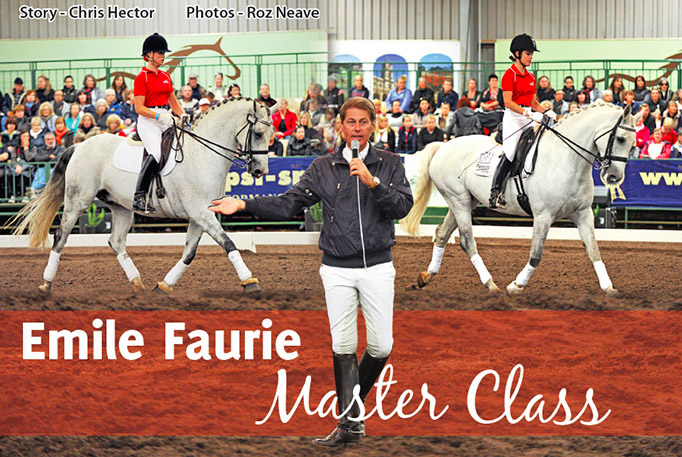 In 2012, Emile Faurie conducted the Masterclass and DJWTS. The audience were treated to a barrage of exercises from Emile. Worth sharing again. Emile is still competing at the top level.
In 2012, Emile Faurie conducted the Masterclass and DJWTS. The audience were treated to a barrage of exercises from Emile. Worth sharing again. Emile is still competing at the top level.
The Master Class made it obvious that Emile is a sophisticated teacher, and equally obviously, he had thought about what he wanted to show, and selected his horses and riders to achieve his aim.
I’m sure it helps that Emile spends so much of his time teaching, as he told me earlier: “I teach every day of my life, every single day.”
And Emile assured me that the lessons were not just to keep food on the table:
“If I had a choice, would I teach? Absolutely, I think you learn so much more about horsemanship through teaching, and I think as a rider if you don’t teach it’s a disadvantage, I really do. I learn a lot from observing from the ground and I learn an awful lot that I actually use in my own riding, from teaching. I think I learn so much from watching and observing different horse and rider combinations from the ground.”
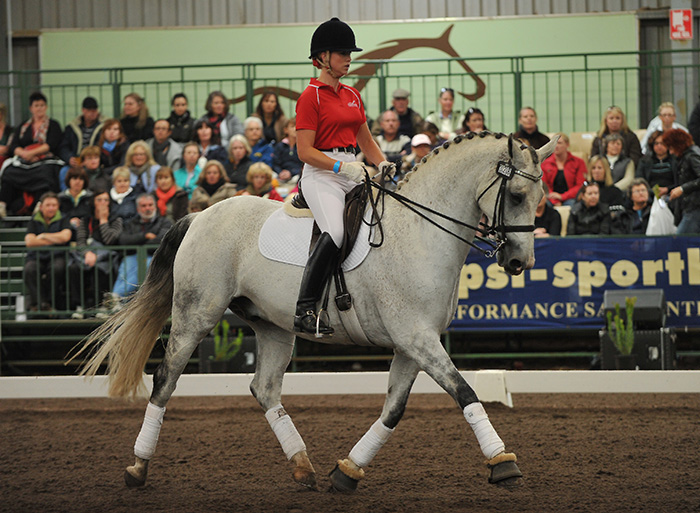
We started with a pair of greys, first Bianca Barnes and Belcam Cadell
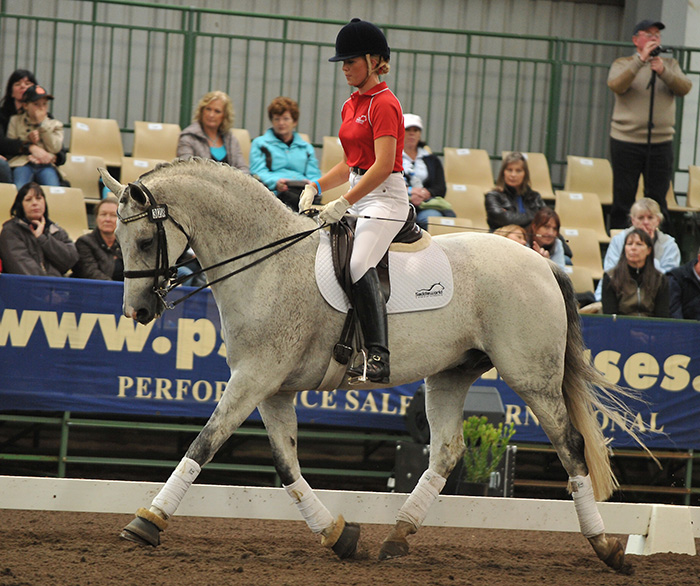
and Kylie Burton and Tamarisk
The first segment was to demonstrate Emile’s warm up exercises, and for this he selected two very pretty riders on matching greys: Kylie Burton and Tamarisk and Bianca Barnes and Belcam Cadell.
Like all good trainers, Emile kept it simple:
“There is no miracle, there is no magic wand. It is just education, trying to be as clear to the horses as you can. When I give an aid, is the horse going to understand?”
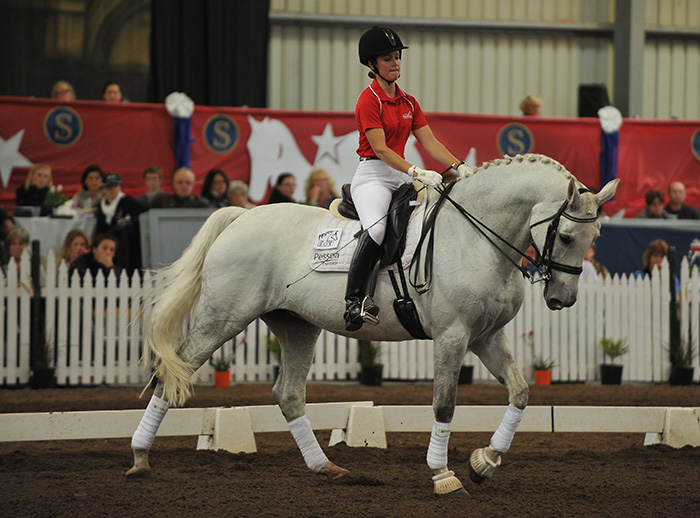
“At the start, I like to spend as much time in walk as possible. At home, my horses are first walked around the gallop track. I remember Herbert Rehbein saying, the longer they walk before they start, the longer they stay sound. Loose rein, stretch, try to get them walking like a cat, through the body and with long stride.”
“I find that when I am judging, I want to award higher marks to a horse that wants to do it, and to achieve that you need a horse in a physically good condition, horses don’t have emotions, you can’t explain things to them, they are happy if they feel physically well. If they are never pressured to do something they find physically difficult, then they will always look as if they want to do the test…”
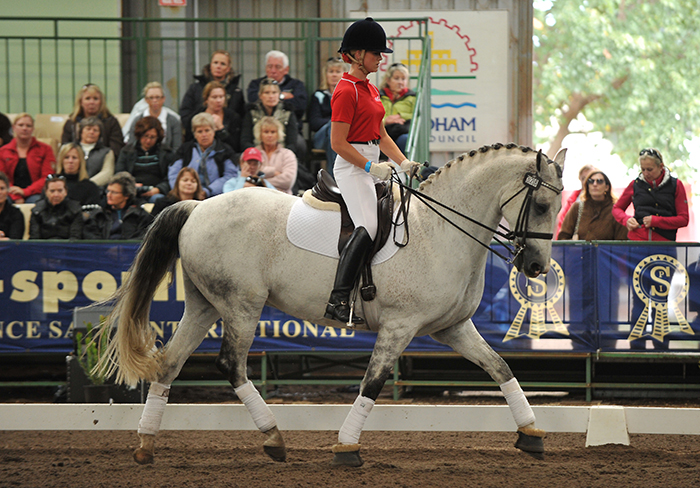
“I have a very strict pattern of working-in and always start in working trot rising. If a horse breaks into canter, that’s good, that shows spirit, as long as the horse isn’t doing it out of fear.”
And, of course, no discussion of working-in dressage horses is complete without a consideration of the dreaded deep and low issue…
“Do we want the horses looking up their own backsides? If the horse is technically correct in its acceptance of the bridle, it doesn’t matter where they put their head and neck. I like to start a little longer and get them swinging through the back. It all comes back to the scale of training, and they can’t be correct if they are not through…”
“Girls, a little stronger, a little rounder, softer. NOT Australian corners, go into the corners, half halts on the outside and support with your inside leg. Now they are swinging, now they are in better rhythm, now go shoulder-in in rising trot. I use this exercise for all my horses, from four-year-olds to Grand Prix horses – of course you cannot expect the four-year-old to produce a perfect shoulder-in. For me, this is a suppling exercise to get the bend through the ribcage and the shoulder. Make sure this is not with a backwards taking contact or you will end up with a tilting head and neck.”
more follows
It is simple work but so nicely thought out…
“Go on the diagonal, and on the second half of the diagonal, leg yield, only leg yield on the second half to keep the rhythm and the cadence – that way we teach the horse to go sideways without losing the throughness of the trot, and we keep the throughness and swing in the rising shoulder-in.”
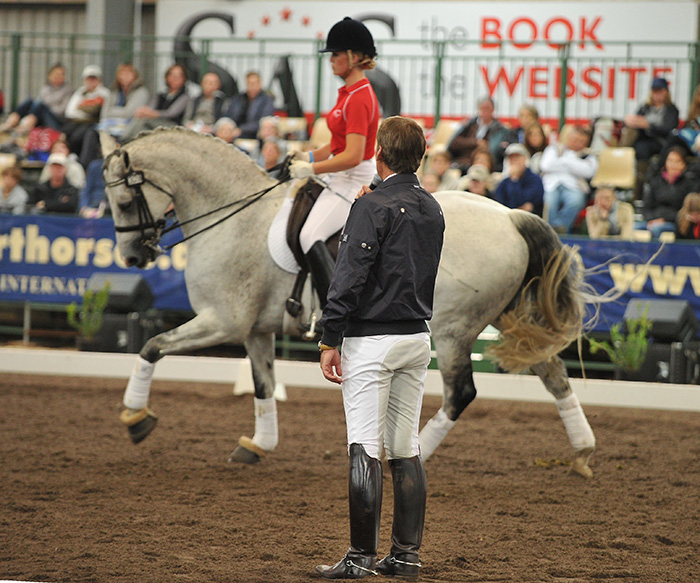
Okay, time for some canter work, and on a twenty metre circle:
“In a nice working pace… at the higher levels, there is lots of collection, and it is such a strain on their bodies. We have to build the joints and limbs to make the work easy for them.”
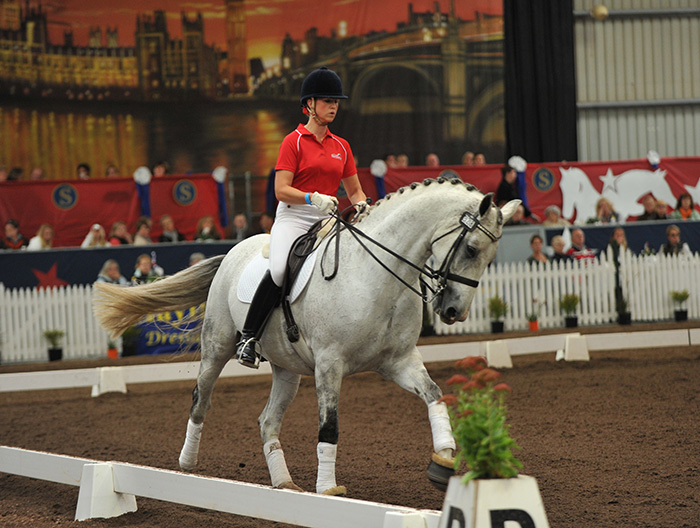
And again, canter shoulder-in as a suppling exercise rather than a test exercise:
“Make the inside leg come under the rider to take the weight, across the short diagonal and into counter canter, and now a downwards transition, but keep the momentum of the pace. We want a canter with a big, bold, ground covering stride, but the horse to have a natural way of carrying itself. And now a counter canter down the long side in medium, really forward, that helps straighten the horse through its body, and really lets it stretch.”
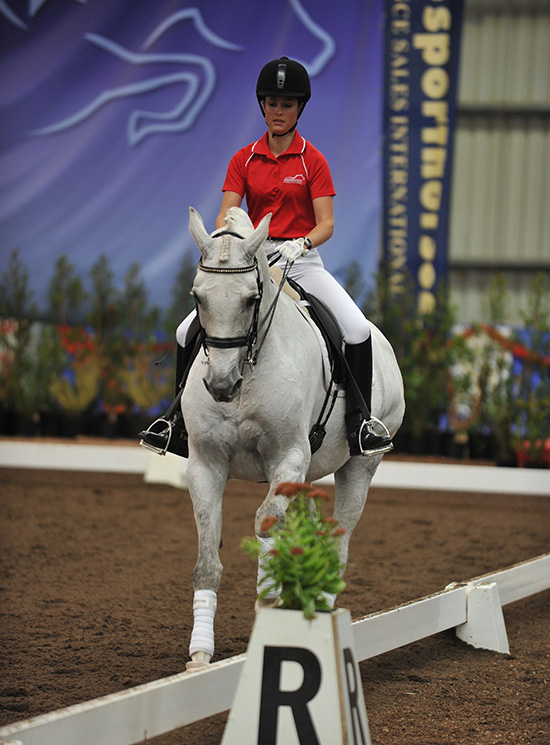
The emphasis is always on the gymnastic quality of the work – even in the flying change…
“A nice big forward flying change, big and expressive. The horse will naturally come back on the short side, so riders don’t have to take the rein. Ride a medium counter canter down the long side, half halt on the short side, and flying change.”
Always the emphasis is on not pulling back:
“The next exercise is to encourage collection without pulling back, Circle me, 20 metres, working tempo, nice balanced rhythm, then 16 metres, circle but working tempo, the half halts from your shoulder and the back of your neck, not your hand or your bicep. Then 12 metres, 10 metres, ride from behind into the half halt. Keep the working tempo, straighten the neck. The horse comes more and more together without being pulled together. And trot, and now we have a balanced working trot.”
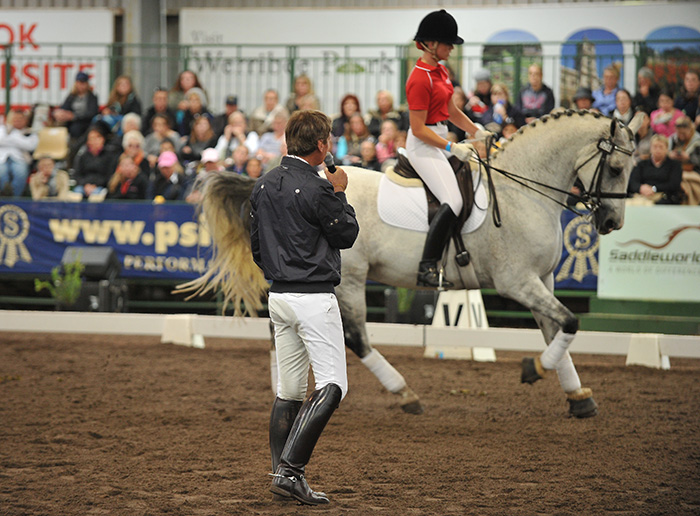
Another collecting exercise on the circle in canter:
“Turn the shoulder in on the circle. Don’t use the outside leg, don’t push the quarters in. This is a very important exercise, collected canter with impulsion and good tempo. And after an exercise like that where you have asked for a condensed frame, then go to working canter and working trot.”
“Use your voice to reward the horse – it takes a long time before the horse is balanced enough for you to reward it by patting with your hand.”
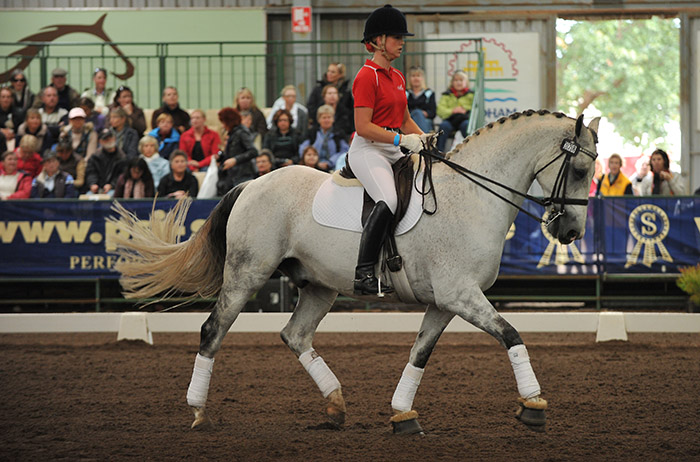
Emile felt that the horses were now ready for a stronger trot:
“Now ride a very measured, very controlled medium diagonal. Controlled, half halts from the shoulders.”
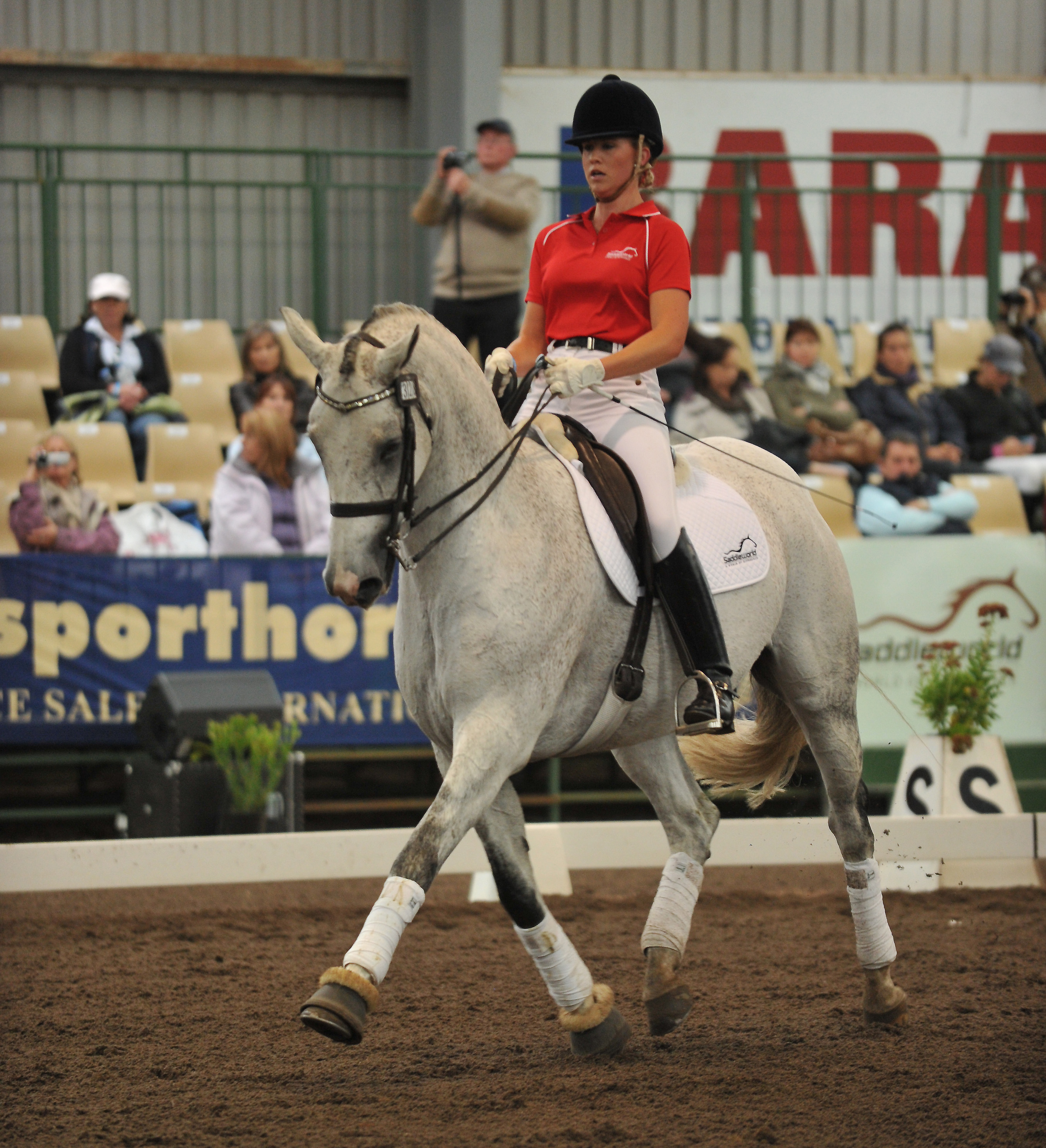
“What is more important is the regularity of the trot, not a trot that flies but is irregular. When you make the transition to walk, ride a six metre circle in walk, that keeps the horse forwards and supple in the downwards transition, make the transition straight into the circle.”
“All this work is to show you a way of coming back to the correct technique rather than using short cuts and pressure.”
And two happy riders, and happy horses, smiled as they left the arena.
Another rider follows
The next rider was Sydney professional, Michelle Baker riding Coldstream Dante, and since Michelle had already warmed the horse in, Emile had carefully avoided the trap of having a master class that endlessly repeated the introductory stage…
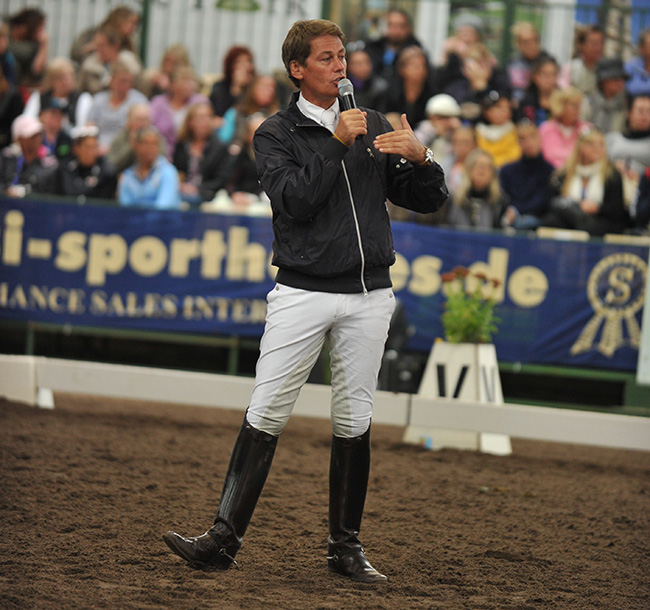
“As if by magic, we are going to skip a few years in training and look at some exercises to improve some of the more difficult movements. The first is an exercise for canter pirouette – and that is all about balance, contact, and most important of all, control. It means good base quality of the canter.”
Michelle was to ride a big circle around Emile in canter and get Dante listening to the half halt. “Forward to walk and halt, walk and halt, rein back three strides. Now rein back two strides without halting, encourage the horse to respond to the half halt but at the end of the rein.”
Michelle and Dante, rein back, and into canter
“Now canter the circle and try to achieve a little more collection, small circle, turn the forehand, turn the forehand, turn the forehand and ride out and change the rein to the inside of the circle.”
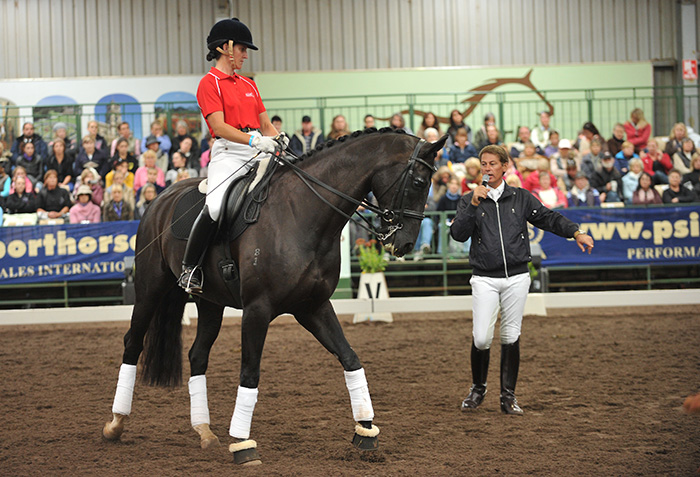
“Walk a ten metre circle, quarters in on the walk, but the shoulders on the line of the circle, now canter with the quarters still in. This is a really good exercise to get the turn of the pirouette with control and ease. Canter, quarters in, shoulder-in on the circle line, then just sit still and turn and ride out.”
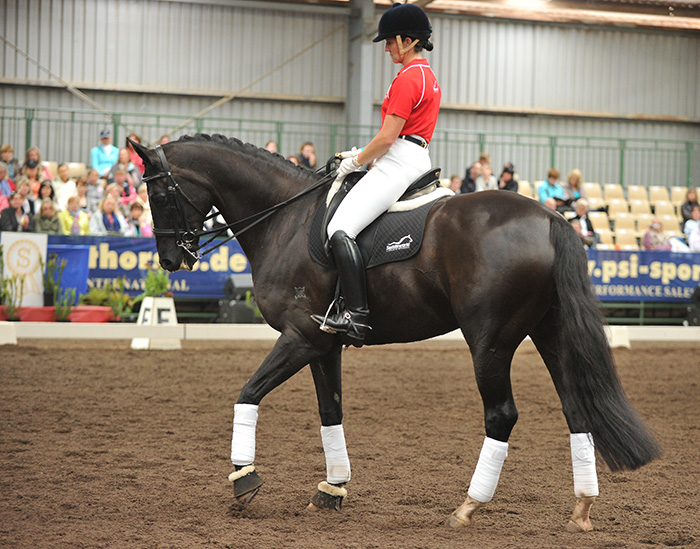
“Now a big training walk pirouette. Careful, the horse shouldn’t cross its hind legs in a walk pirouette.”
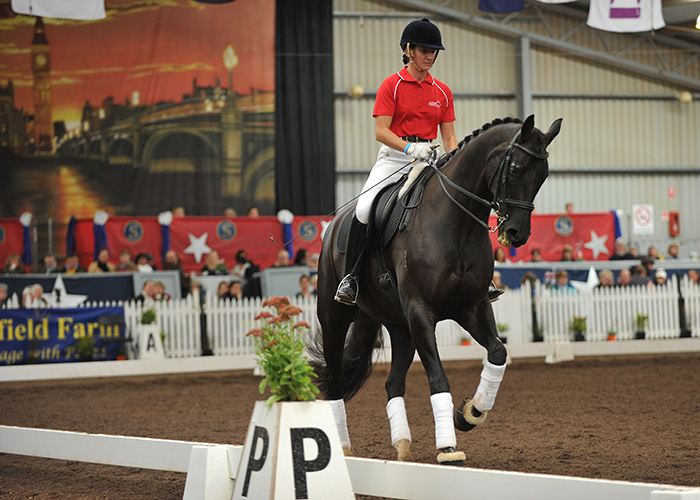
That done it was back to canter:
“Canter straight, come in on the circle, still straight, walk quarters in, and canter, keeping your shoulders parallel to the shoulders of the horse, now ride out and we can see that the quality of the canter has improved.”
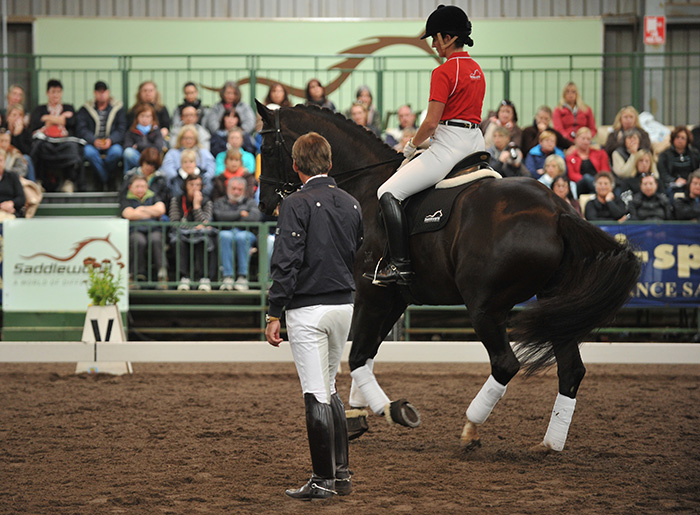
Everything was going well, the horse was looking calm, let’s try a little passage…
“Trot, walk, trot, now almost walk, and a little touch and a few collected strides. The most important thing is to keep it easy, a few quality strides with ease and rhythm, and you have the beginnings of passage.”
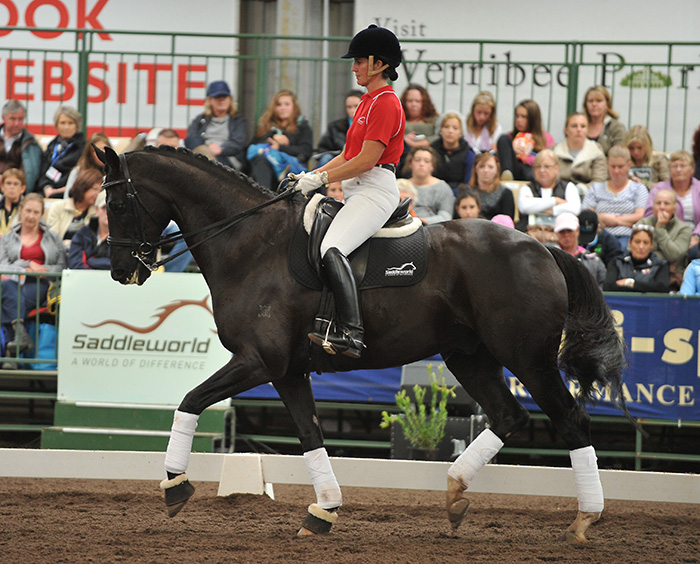
“Let’s try it on the other rein, trot, walk, trot, touch, half halt… the moment you lose an inch of regularity go out, and then repeat the exercise. Don’t think of riding the passage strides, think of the transition. It’s about the initiation into passage – make it easy and increase his willingness to want to do it.”
It was another entrancing lesson, and it really helped that in Michelle, Emile had a rider who could instantly respond and do what was asked…
Another combination to come
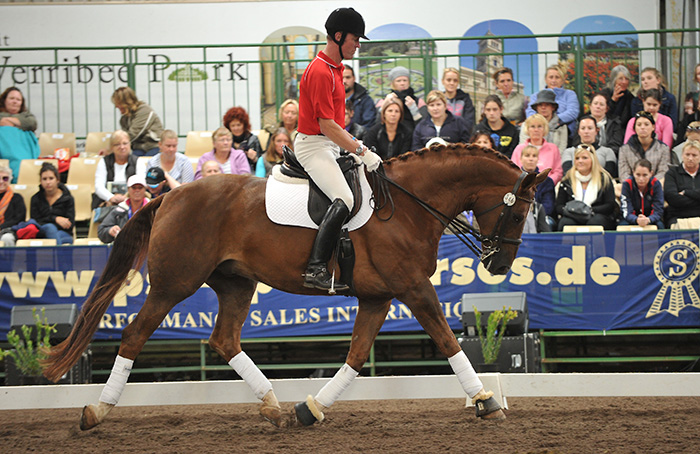
The next rider into the ring is Matthew Dowsley riding the very fancy Falsterbo son, Falstermeyer.
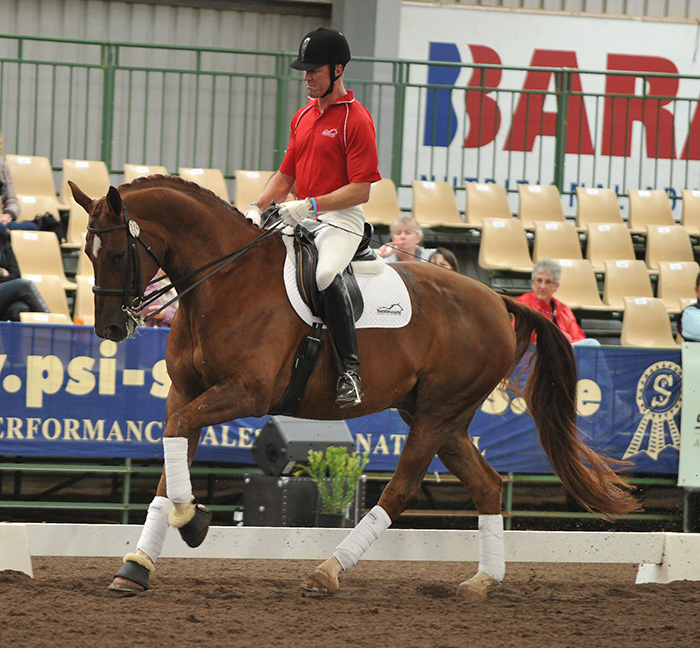
“Now we’ve skipped another year or so. The higher the level, the longer and more careful I am with the working-in process. The higher you get the more you have to concentrate on the well-being of the horse’s muscles and his frame.”
“You can work the horse longer and lower but the horse has to still be in good balance. If there is a change in the quality of the stride, then long and low is not so good.”
Let’s see what he looks like in canter:
“With this horse, we are trying to get the canter stride to cover more ground, so get him a little shoulder fore, get the hindlegs into the shoulder. This horse has a a tendency to draw back into himself, he’s shy like me (that’s a joke, Joyce) and we have to encourage him to open up. Matthew you can even lean forward slightly out of the saddle.”
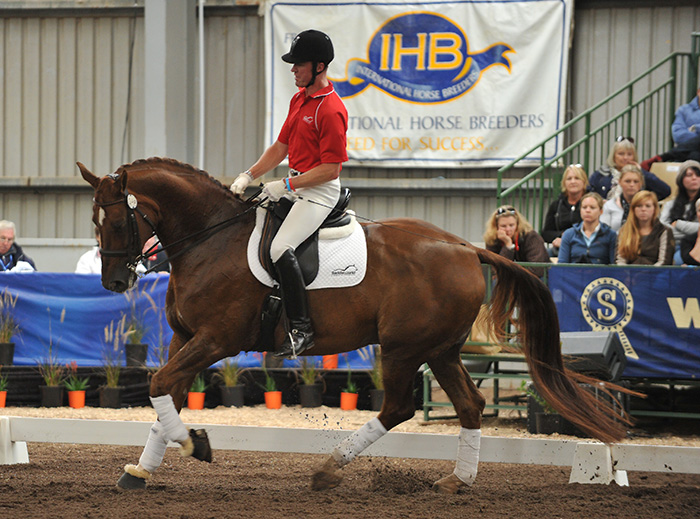
“The most important thing is for the horse to want to go – after all we get a mark for it at the end of the test, it is called impulsion.”
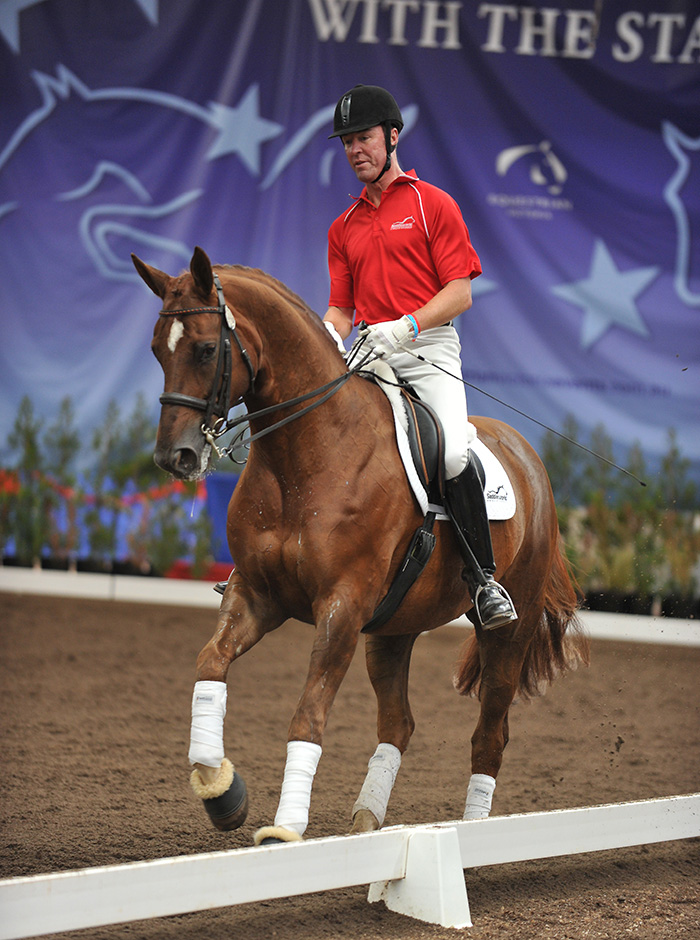
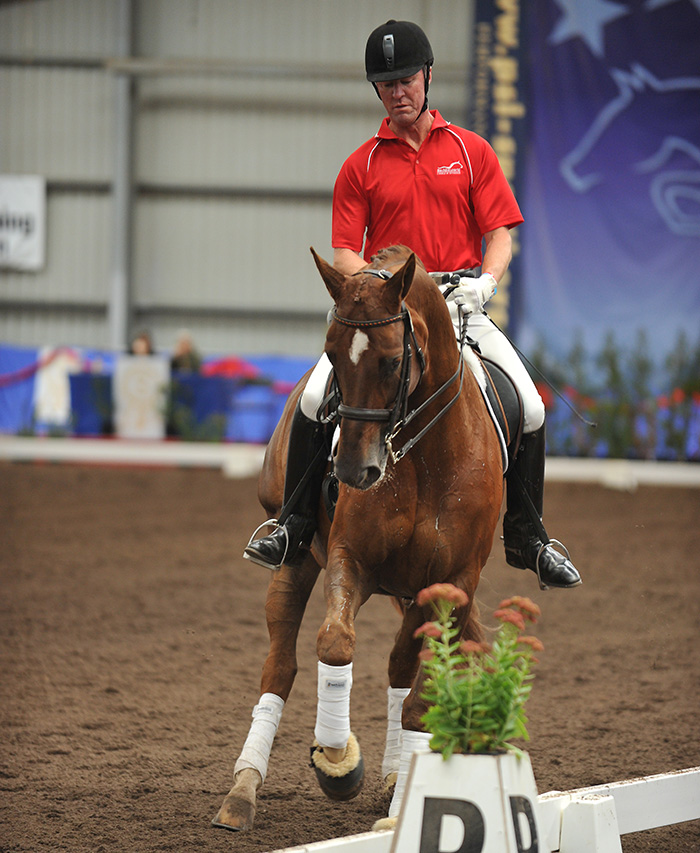
“Ride half the long side in shoulder fore, and half the long side in travers, we want to encourage suppleness.”
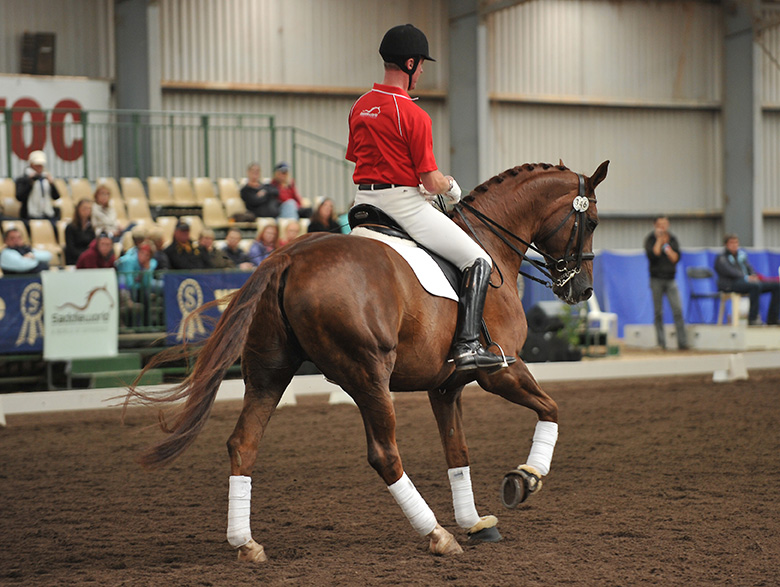
“Now ride a half pass right, but be careful that the shoulders are positioned to the right before asking for the quarters. Right now we are using the half pass diagonal as a suppling exercise, in a test we would be asking for more collection. We are seeing better throughness now, the horse is straighter.”
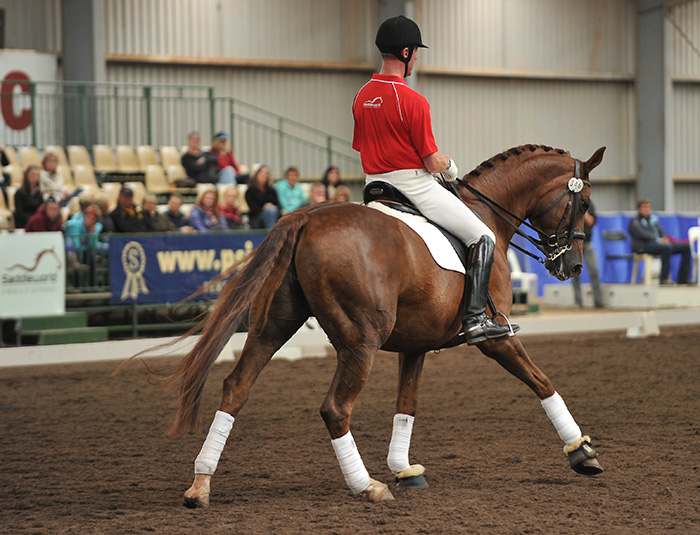
Now for one out of the left field:
“Ride a line of twos on the long side. I quite often do that straight after working-in, when you ride a line of twos, it tells you how much you have the horse on your aids, it tests your two times changes, and improves throughness and straightness, provided you’ve worked them in properly. If you have a mistake, you know that your working-in routine is not proper.”
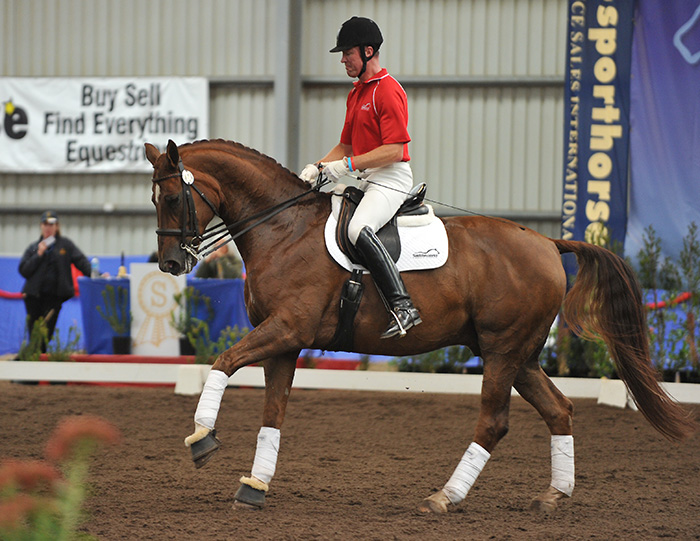
“If he feels behind you, go back to walk. Walk / trot / walk – better than time, he went into trot without help.”
“Now ride from X to M, not in half pass but in travers. This encourages freedom in the horse’s shoulders. Keep your thumbs pointed to the horse’s ears, and the ears pointed to the markers… and keep the cadence in the trot.”
The next exercise is to help with the canter zig zag: “Half pass to X, then straight down the centre in shoulder-in, and at the end of the centre line, a flying change.”
Now the flying changes are coming thick and fast, fours down the long side, threes across the diagonal…
“Let’s be greedy, and the short diagonal ask for three ones… They were good, let go and ride on, now another short diagonal and five ones, now on the longer diagonal, eleven ones, sit still and trust the horse. Although the ones got a little shorter, he is a young horse, they were still technically correct. It is better to ride fewer changes and encourage the horse to go forward.”
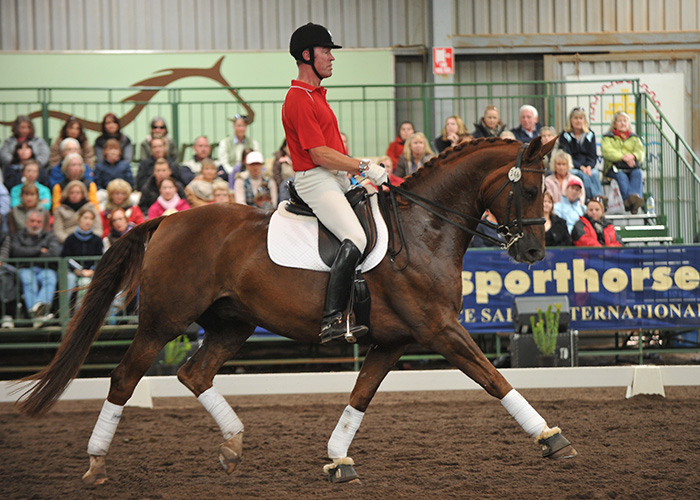
And Emile also wanted Matthew to ride forward into the passage:
“Trot forward and then passage. Trot half pass to the track and into passage – it’s good to ride passage out of the lateral movement, it is a way of making sure you ride forward to passage. Keep the passage collected and a little smaller and develop ‘push’. Now medium trot on the diagonal, regulate the rhythm, now medium to E and walk and medium trot and walk and medium and walk. Now medium trot from M to B, walk at B and medium trot. Now a medium across the diagonal. The transitions are a nice way of getting them to respond to the half halt.”
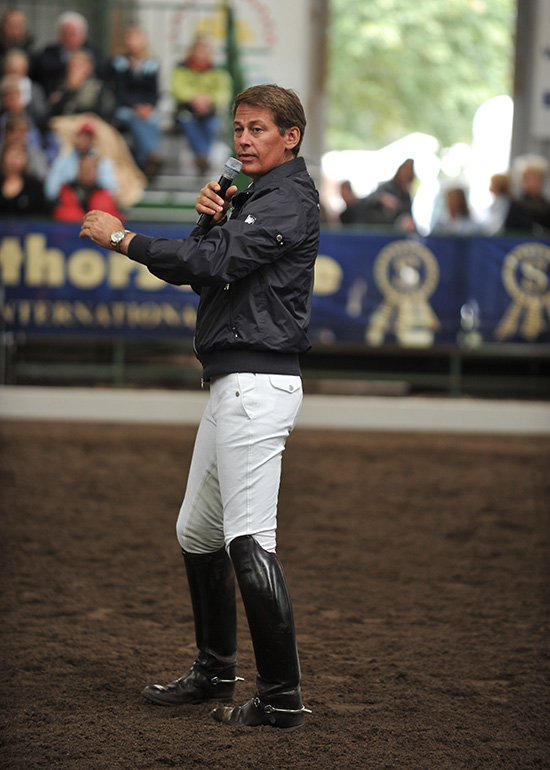
Really Emile summed up his message in his final comment:
“There are many different schools of training – the one thing that is most important is the welfare of the horse, the one thing we must concentrate on is producing healthy and strong horses.”
Furst Belissaro, combining the bloodlines of Furstenball and Belissimo.
Find out more about this exciting stallion, go to www.ihb.com.au
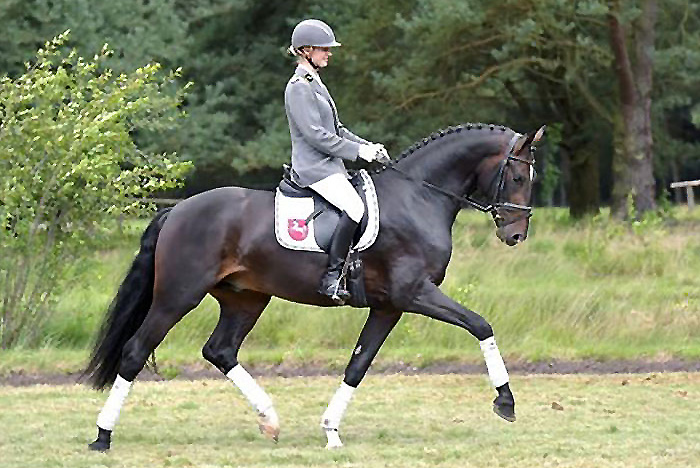
Or Dancier, representing the D line

